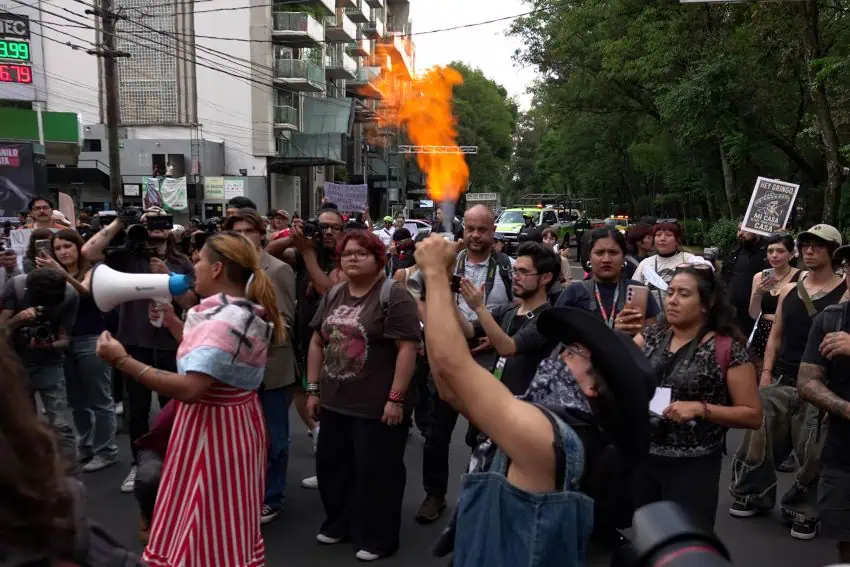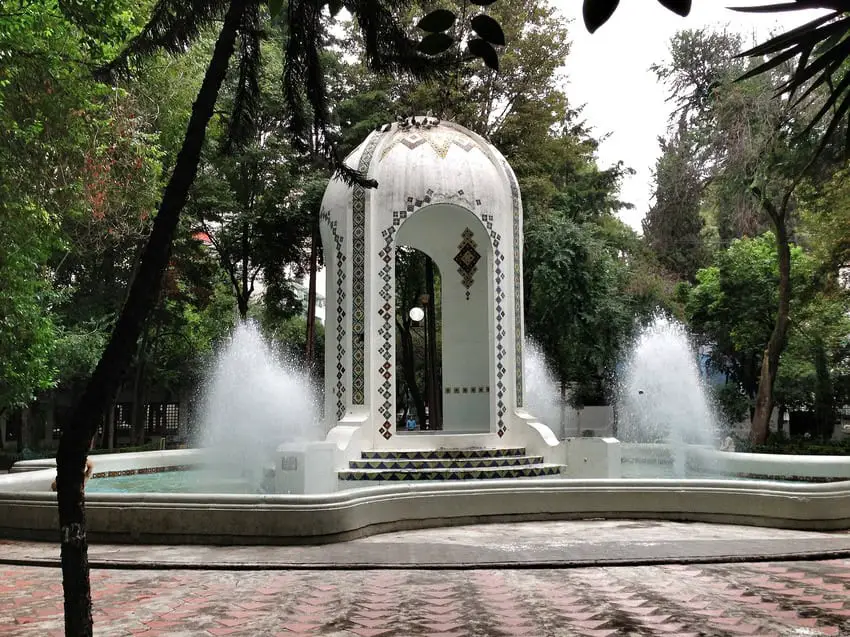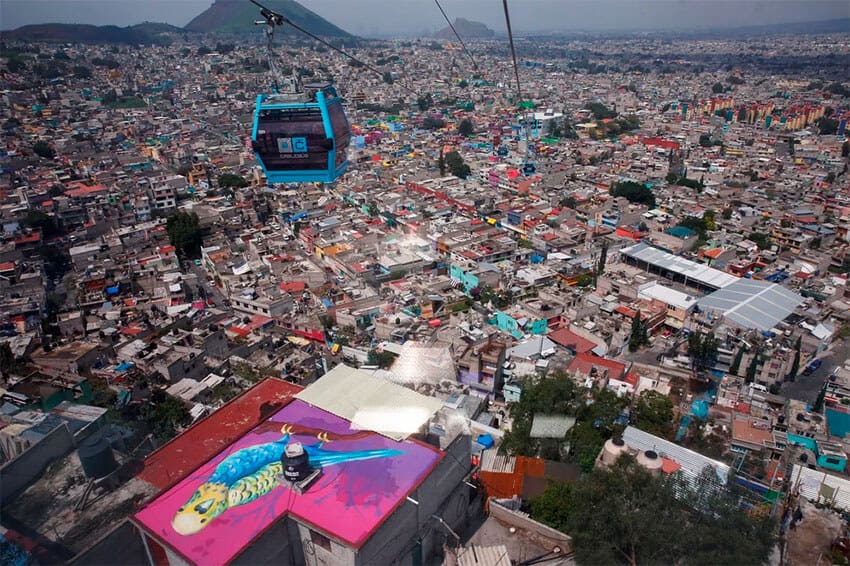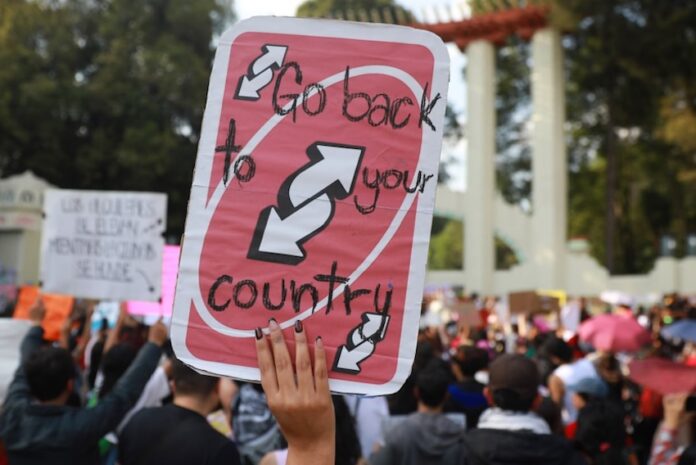On July 4, there was an anti-gentrification demonstration marched through the streets of Mexico City’s Colonia Roma and up to the U.S. embassy. While the purported purpose of the march was to condemn the rising rents and unaffordability of the capital, to an outsider, it could have easily been perceived as an anti-immigration rally.
The most repeated chants were “Fuera Gringos!” — Gringos out! — and “No se van a ir, los vamos a sacar”: “They aren’t going to leave, we’re going to kick them out.” These were joined by signs reading “Gringo culero, my people are first” and “We don’t hate you because you are gringos, we hate you because you’re culerxs.” The word “culero” has a variety of meanings, including coward, disloyal, freeloader and asshole.

The aftermath of the march included broken storefronts, looting, and graffiti that read “Learn Spanish” and “Gringos go back to your f*cking country” — making it all feel like it could have been right at home in MAGA country in the United States, with the obvious difference that there, the slogans would be anti-Mexican.
Mexico City, like all great cities, is essentially multicultural. Since its foundation, it has been home to immigrants and transplants. In the past several years, the city has seen an increase in the number of foreign residents — particularly from the United States — living in a handful of neighborhoods at the city’s center, specifically Roma, Condesa, Polanco and the Historic Center. Official statistics from Segob cite the city-wide population of U.S.-born residents at 19,122 in 2022, an increase of almost 70% from 2019 but still only 18% of the over 100,000 foreign-born residents in a city of more than 9 million people.
Despite those low percentages, social media videos abound about how the city’s salsa is no longer spicy and that everywhere one goes in the aforementioned neighborhoods mentioned, you will hear English spoken and be offered English-language menus. And the biggest complaint is gentrification, which residents like these protesters blame on the influx of digital nomads and other foreigners with greater buying power.
The anger about gentrification is real and valid. It’s a global phenomenon and we have seen similar demonstrations in cities across the world in the past several decades. Rising rents displace long-standing residents while big chains homogenize neighborhoods and push out local businesses while creating long commutes for minimum wage workers who can’t afford to live in the neighborhoods where they work. All of these realities are alarming symptoms of a free-market economy where the spoils — in this case, homes and a central location — go to those who can pay the highest price.
The gentrification in Mexico City is multifaceted and its roots include real estate speculation, the deluge of vacation rentals, an extreme lack of not only affordable housing but housing in general, and the centralization of economic and cultural activity in the city center, among many other factors.
Long-standing tensions stemming from U.S. policies towards Mexico and Mexican immigrants have only added fuel to the fire. But the idea that the gentrification of Mexico City is due to a handful of digital nomads from the pandemic onward is misleading at best. This process has been a long time coming and from a lot of different directions.

Cities, by their very nature, are in a constant process of evolving, shifting and changing, and Mexico City is no different. As a single example, in the early 20th century, Roma and Condesa were built as enclaves for the urban elites, old-moneyed Mexicans as well as industrialists who got rich during the government of Porfirio Díaz. In designing these neighborhoods, city planners were responding to an overflowing Historic Center that in the late 19th and early 20th centuries more than doubled in population.
In the 1920s, a community of Syrian Jews moved from the Historic Center into La Roma, making it very much their own, with Jewish bakeries and kosher butchers in the Mercado Medellín. In the 1940s and ‘50s, migrants from rural areas of Mexico migrated massively into the city in search of work, and European refugees from both World Wars were welcomed with open arms. Veterans from the United States came across the border and also found a home in Roma. The Mexico City College — today the Universidad de las Américas Puebla and the Universidad de las Américas, A.C. — opened, offering classes in English.
By the 1970s and ‘80s, a process of de-gentrification was happening in Roma and Condesa, as these neighborhoods had become solidly middle class, with many higher-earning residents moving to newly built and wealthier neighborhoods like Las Lomas and Polanco. The 1985 earthquake hit both neighborhoods hard, in particular Roma, which spiraled into decline for the 15 years from the earthquake to the dawn of the new millennium.
But both of these neighborhoods have been rapidly transforming for the last 25 years. In the beginning of the 2000s, the city’s 50-year rent freeze was lifted and many Mexican investors saw an opportunity, beginning to purchase property and renovate buildings. The more popular Roma and Condesa became, the higher the rents went. In other words, these neighborhoods have long been inaccessible to the majority of average city workers.
With a history like this, the question of who is a local becomes a tricky one. Are the original wealthy landowners the true residents of Roma? The Jewish families that moved here after? The migrants from other Mexican states who came later? Am I local? I’ve lived in Roma for 14 years and was myself forced out of my apartment of 12 years along with my neighbors, some of whom had been living in the building for over 30 years, under the guise of “renovations.” I am also now a part of this neighborhood and its history.
The majority of the country’s economic and cultural activity takes place in the center of Mexico City, making this area a favorite and convenient place to live. Residents here, both Mexican and foreign, know that it implies paying a premium for the opportunity. In a recent TikTok, social commentator Vero Teigerio talks about the difficulties in decentralizing the economic activity of the city, which relies on a certain level of density in order to function. She points out that while the city’s population is 9.2 million, the surrounding municipalities add nearly 12 million more, and there’s no way all 20 million plus can live in the city center.

One of the solutions that Teigerio presents is improving the quality of services such as water and electricity and urban infrastructure — such as public parks and cultural spaces — outside of the city center. If peripheral areas could be made workable and pleasant to live in, and if mass transit were improved so that workers could have a comfortable 45-minute ride into the center rather than a hellacious two-hour commute, demand for housing in the city’s core might go down as people living in other neighborhoods enjoyed the quality of life of those living downtown. But, Teigerio points out, inequality of services runs deep, and local politicians don’t have much enthusiasm for changing the status quo.
Mexico City is also in desperate need of more housing, affordable housing, and caps on rent that will keep landlords and real estate companies from charging whatever they think that people will be willing to pay.
The city’s latest reforms seem an attempt to address these concerns. For some, they are worthless, token gestures; for others, they represent a first small step in the right direction. The reforms cap rent increases based on yearly inflation, require rental contracts to be publicly registered and limit both the quantity of Airbnbs that individuals can own and the number of days out of the year they can be rented out. While the Airbnb occupancy caps seem like an odd addition (if you have an Airbnb, you likely won’t be able to rent it for six months as a vacation rental and the other six months to a local resident), that may be the idea: to dissuade property owners from operating an Airbnb to begin with. The mayor’s office also committed to getting 20,000 affordable homes on the market by 2030, but previous administrations have made and broken similar promises.
Will these policies be enough to curb rising rents? Will the current administration be able to deliver affordable housing at a rate that meets the needs of residents? Will the organizers of the anti-gentrification march be able to move beyond their hostility towards immigrants to build a coalition to fight the root causes of gentrification?
“Gringos love Mexico but they hate Mexicans,” another sign seen at the march, is quite an accusation. While there are certainly immigrants to Mexico City who are culturally oblivious, the vast majority of those who live here full time do so because they love it. “Mexico for Mexicans” smacks of another slogan we’re hearing a lot of recently, one whose parallels I would think would make anyone who cares about progressive values think twice.
The truth is that there are thousands of immigrants, not only from the U.S. but from Korea, China, Japan, Argentina, Colombia, Venezuela and all over Europe who have chosen to make Mexico City their home. And for most, it’s not about cheap rents or bland salsa but because they are passionate about the chaos, beauty, food and life of this metropolis. Many of them are likewise concerned about the rising cost of living and could likely be persuaded to join the cause.

I know that anything I write, by the mere fact that I am a foreigner, will be seen as being an apologist for foreigners and for the gentrification of central Mexico City. I don’t defend my countrymen; we can be annoying and disrespectful guests. I understand the history that has made relations between the United States and all of Latin America filled with resentment and anger. But the socially corrosive and xenophobic rhetoric heard at the march misses the point. Not every foreigner is a gentrifier and not all locals are suffering. Gentrification is about systems and class, not nationalities. It’s about a right to the city and a right to housing. We must learn to separate our economic systems (and our governments) from the people who function within those structures.
Over the years, I have written about a lot of immigrant communities in Mexico. What I have taken from listening to their stories is the overwhelming sense that they have deeply enriched the city’s food, art and culture. Throughout the 20th century, Lebanese, Armenians, Chinese, Japanese, Colombians, Argentinians, Koreans and many, many other immigrant groups have each added their own touch to the city’s life.
While “the other” is an easy target in times of crisis, it’s important to remember that Mexico City’s multiculturalism is one of the things that makes it vibrant, and why it is beloved by so many. As human beings, we all have the right to move freely across borders. Migration is not the problem, neither in Mexico or the United States, the system is.
Lydia Carey is a freelance writer and translator based out of Mexico City. She has been published widely both online and in print, writing about Mexico for over a decade. She lives a double life as a local tour guide and is the author of “Mexico City Streets: La Roma.” Follow her urban adventures on Instagram and see more of her work at mexicocitystreets.com.
